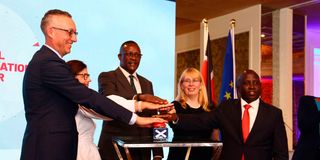Kenya’s digital economy unfolds

From left: Ambassador of the Federal Republic of Germany in Kenya Sebastian Groth, Ambassador of the European Union to Kenya Henriette Geiger, Ministry of Information, Communication and the Digital Economy CS Eliud Owalo, Department for Development Cooperation and Humanitarian Aid Kairi Saar-Isop, Principal Secretary State Department for Information Communications Technology John Tanui launch the Kenya Team Europe Initiative Digital Transformation Centre at Villa Rosa Kempinski, Nairobi on May 19, 2023.
As we reflect upon the achievements of the first year of the Kenya Kwanza Government, I would like to take stock of the digital superhighways’ contributions to the socio-economic transformation of our country, which is well and truly on course under the leadership of the President, Dr. William Samoei Ruto.
Kenya’s Digital Masterplan 2022-2032 recognises infrastructure as the foundation upon which all Information, Communication, and Digital Technologies and any progress emanating thereof are anchored.
For this reason, under the Infrastructure Pillar, we have embarked on laying 100,000 km of fibre-optic cable countrywide.
This will include currently unserved and under-served areas to provide access to some 8.5 million homes and businesses, 1,450 wards, 400 police stations, 13,000 health facilities, 40,000 public schools, markets, and other public institutions over the next five years.
Without digital infrastructure, Kenya cannot benefit from the Fourth Industrial Revolution and the disruptive technologies and trends such as the Internet of Things (IoT), robotics, virtual reality, Fin-Tech, e-commerce, 5G technologies and artificial intelligence (AI) that are the new frontier for economic transformation globally.
Working with partners in the private sector over the past 12 months, I can report that the MIC-DE successfully rolled out an additional 8,419 Km of fibre optic cable countrywide. This is a significant precursor to our digital transformation journey.
Having recently successfully negotiated World Bank funding for the Kenya Digital Economy Acceleration Program worth $570 million and additional Sh5B from the Universal Service Fund to support our programmes, we project to add another 10-15,000 Km in the next year to the the National Optic Fiber. Backbone Infrastructure (NOFBI) project.
To realise the full utility value of the NOFBI, it must bring socio-economic transformation to citizens by opening up opportunities for job creation, support business, and e-commerce, education, innovation, access to online and GoK e-services, e-health, e-agriculture, the creative economy and spur inclusive growth.
This requires providing internet connectivity to people via last-mile connectivity, which connects the main backbone and the users. Consequently, GoK, partnering with private sector ISPs, is installing 25,000 free public WiFi hotspots in public places, providing affordable internet connectivity to millions of Kenyans. So far, the MIC-DE has installed 518 Free WiFi hotspots. This is bound to expand exponentially as we expand NOFBI countrywide.
The uptake and subsequent benefit from this ICT infrastructure and its inherent technologies is directly proportionate to the ICT literacy of the users. Our Digital Masterplan emphasizes investing in digital skills to optimise digital opportunities and socio-economic transformation.
Consequently, over the last 12 months, the MIC-DE has provided connectivity to 116 educational institutions, primarily TVETs and, equipped them with 11,400 internet access devices, and trained 390,968 individuals through the Jitume and Ajira programmes.
This has registered a tremendous success rate, with 119,462 youth gaining employment in digital and physical ICT-related jobs through this intervention.
To further enhance access, promote innovation and use of emergent digital technologies, and offer ICT literacy, we purpose to establish 1,450 digital innovation hubs, one in each ward.
We have successfully operationalised 247 hubs with access to high-speed internet and learning centers with a capacity for 30 to 100 cohorts, workstations, innovation labs, Wi-Fi hotspots, and Co-working Spaces.
These hubs can potentially train 300 youth and create a corresponding number of digital jobs , giving an average of 1,500 digital jobs per constituency.
The MIC-DE has been working with Members of Parliament to amend the NG-CDF Act to enable utilisation of CDF for OPEX sustenance of the hubs. Parliament has already passed the amendment now awaiting assent.
The Presidency is also leading from the front in adopting digital services, and as of January 2023, all Cabinet meetings have since gone digital.
To enable citizens to access GoK and other digital services seamlessly and securely in the public and private sectors, the GoK is pursuing a digital identity to facilitate virtual consumption of government services.
While a lot of work remains to be done, the progress made so far is encouraging. According to the World Bank, Kenya’s ICT sector’s growth has outperformed every other sector, expanding by 23% annually during the last decade.
The industry is now six times larger than it was at the beginning of the decade. With your participation and support, we look forward to an empowered, digitalized and globally competitive Kenyan siciety. Our Digital and 24-hour economy is in the horizon.
- The writer is the Cabinet Secretary, Ministry of Information, Communications and the Digital Economy in Kenya.




